Posterior Tibial Nerve Schwannoma in the Popliteal Fossa: A Case Report
Luis López-González MSc, PT1,2, Daniel Pecos-Martín PhD, MSc, PT1, Mª Teresa Gómez-González PT1,2, Samuel Fernández-Carnero, PhD, MSc, PT1, Tomás Gallego-Izquierdo PhD, MSc, PT1
1Department of Physiotherapy, University of Alcalá, Alcalá de Henares, Spain
2University Hospital Ramón y Cajal, Madrid, Spain
*Corresponding Author: Mª Teresa Gómez-González, Department of Physiotherapy, University of Alcalá, Alcalá de Henares, Spain
Received: 11 May 2020; Accepted: 28 May 2020; Published: 08 July 2020
Article Information
Citation: Luis López-González, Daniel Pecos-Martín, Mª Teresa Gómez-González, Samuel Fernández-Carnero, Tomás Gallego-Izquierdo. Posterior Tibial Nerve Schwannoma in the Popliteal Fossa: A Case Report. Archives of Clinical and Medical Case Reports 4 (2020): 612-618.
View / Download Pdf Share at FacebookAbstract
Schwannomas are uncommon disorders of peripheral nerves sheaths, presenting with particular neuropathic manifestations that are often misdiagnosed or undiagnosed. We offer a case report of a 36-year-old patient with an untypical schwannoma in the tibial nerve, causing long-lasting and increasingly exacerbated pain, misdiagnosed as a meniscus tear. The worsening symptoms, including hyperalgesia, allodynia and hypersensitivity, raised suspicion of malignancy. The patient underwent an ultrasound examination, where a compressive neuropathy was suspected. Finally, the presence of a large benign schwannoma was confirmed by magnetic resonance imaging. The tumour mass was excised and this gave way to a total and rapid relief of symptoms.
Keywords
Peripheral nerve tumours; Nerve sheath tumours; Tibial nerve; Schwannoma; Case report
Peripheral nerve tumours articles, Nerve sheath tumours articles, Tibial nerve articles, Schwannoma articles, Case report articles
Peripheral nerve tumours articles Peripheral nerve tumours Research articles Peripheral nerve tumours review articles Peripheral nerve tumours PubMed articles Peripheral nerve tumours PubMed Central articles Peripheral nerve tumours 2023 articles Peripheral nerve tumours 2024 articles Peripheral nerve tumours Scopus articles Peripheral nerve tumours impact factor journals Peripheral nerve tumours Scopus journals Peripheral nerve tumours PubMed journals Peripheral nerve tumours medical journals Peripheral nerve tumours free journals Peripheral nerve tumours best journals Peripheral nerve tumours top journals Peripheral nerve tumours free medical journals Peripheral nerve tumours famous journals Peripheral nerve tumours Google Scholar indexed journals tumours articles tumours Research articles tumours review articles tumours PubMed articles tumours PubMed Central articles tumours 2023 articles tumours 2024 articles tumours Scopus articles tumours impact factor journals tumours Scopus journals tumours PubMed journals tumours medical journals tumours free journals tumours best journals tumours top journals tumours free medical journals tumours famous journals tumours Google Scholar indexed journals Nerve sheath tumours articles Nerve sheath tumours Research articles Nerve sheath tumours review articles Nerve sheath tumours PubMed articles Nerve sheath tumours PubMed Central articles Nerve sheath tumours 2023 articles Nerve sheath tumours 2024 articles Nerve sheath tumours Scopus articles Nerve sheath tumours impact factor journals Nerve sheath tumours Scopus journals Nerve sheath tumours PubMed journals Nerve sheath tumours medical journals Nerve sheath tumours free journals Nerve sheath tumours best journals Nerve sheath tumours top journals Nerve sheath tumours free medical journals Nerve sheath tumours famous journals Nerve sheath tumours Google Scholar indexed journals Tibial nerve articles Tibial nerve Research articles Tibial nerve review articles Tibial nerve PubMed articles Tibial nerve PubMed Central articles Tibial nerve 2023 articles Tibial nerve 2024 articles Tibial nerve Scopus articles Tibial nerve impact factor journals Tibial nerve Scopus journals Tibial nerve PubMed journals Tibial nerve medical journals Tibial nerve free journals Tibial nerve best journals Tibial nerve top journals Tibial nerve free medical journals Tibial nerve famous journals Tibial nerve Google Scholar indexed journals Genetic mutation articles Genetic mutation Research articles Genetic mutation review articles Genetic mutation PubMed articles Genetic mutation PubMed Central articles Genetic mutation 2023 articles Genetic mutation 2024 articles Genetic mutation Scopus articles Genetic mutation impact factor journals Genetic mutation Scopus journals Genetic mutation PubMed journals Genetic mutation medical journals Genetic mutation free journals Genetic mutation best journals Genetic mutation top journals Genetic mutation free medical journals Genetic mutation famous journals Genetic mutation Google Scholar indexed journals treatment articles treatment Research articles treatment review articles treatment PubMed articles treatment PubMed Central articles treatment 2023 articles treatment 2024 articles treatment Scopus articles treatment impact factor journals treatment Scopus journals treatment PubMed journals treatment medical journals treatment free journals treatment best journals treatment top journals treatment free medical journals treatment famous journals treatment Google Scholar indexed journals CT articles CT Research articles CT review articles CT PubMed articles CT PubMed Central articles CT 2023 articles CT 2024 articles CT Scopus articles CT impact factor journals CT Scopus journals CT PubMed journals CT medical journals CT free journals CT best journals CT top journals CT free medical journals CT famous journals CT Google Scholar indexed journals Case report articles Case report Research articles Case report review articles Case report PubMed articles Case report PubMed Central articles Case report 2023 articles Case report 2024 articles Case report Scopus articles Case report impact factor journals Case report Scopus journals Case report PubMed journals Case report medical journals Case report free journals Case report best journals Case report top journals Case report free medical journals Case report famous journals Case report Google Scholar indexed journals kidney articles kidney Research articles kidney review articles kidney PubMed articles kidney PubMed Central articles kidney 2023 articles kidney 2024 articles kidney Scopus articles kidney impact factor journals kidney Scopus journals kidney PubMed journals kidney medical journals kidney free journals kidney best journals kidney top journals kidney free medical journals kidney famous journals kidney Google Scholar indexed journals Schwannoma articles Schwannoma Research articles Schwannoma review articles Schwannoma PubMed articles Schwannoma PubMed Central articles Schwannoma 2023 articles Schwannoma 2024 articles Schwannoma Scopus articles Schwannoma impact factor journals Schwannoma Scopus journals Schwannoma PubMed journals Schwannoma medical journals Schwannoma free journals Schwannoma best journals Schwannoma top journals Schwannoma free medical journals Schwannoma famous journals Schwannoma Google Scholar indexed journals
Article Details
Abbreviations:
MRI- Magnetic Resonance Imaging; RUSI- Rehabilitive Ultrasound Imaging; VAS- Visual Analogue Scale; POCUS- Point of Care Ultrasound; PET/TC- Positron Emission Tomography/Computed Tomography; NF2- Neurofibromatosis Type 2
1. Introduction
Schwannomas, which are also termed neurilemmomas in the current literature, are defined as benign peripheral nerve tumours which affect Schwann cells in cranial and spinal nerve sheaths [1, 2]. This condition is extremely unusual in the lower limb (less than 25% of all benign tumours) [3, 4], and it can be considered “singular” when it occurs in the tibial nerve (approximately 5% of all benign tumours) [4]. However, it is “extraordinary” when located in the popliteal fossa. These tumours tend to occur during middle age (20-50 years old) and very rarely initiate malign transformation [1,5]. The patient’s clinical manifestations can include both pain and neuropathic symptoms such as altered sensation, paresthesia or motor weakness [1, 2].
2. Case Report
2.1 HistoryA 36-year-old male with no significant medical or surgical history visited Physiotherapy 15 years after first reporting pain in the right popliteal fossa after some days of skiing practice. At that time, it was classified as pain with non-traumatic etiology. The pain began insidiously and radiated into the anterior and posterior distal third of the thigh during combined flexion-rotation knee movements while reproducing skiing movements. The symptom was also elicited with palpation and compression manoeuvres on the popliteal fossa that the patient described as a local “jab”, but it was not painful at rest. The patient was first referred to an orthopaedist, who prescribed a simple x-ray and diagnosed the clinical manifestations as a degenerative meniscal tear affecting the lateral meniscus. After this first episode the patient continued experiencing both intermittent discomfort events in his normal daily life activities and increased pain in connection with higher physical demands. While he remained asymptomatic during physical activity (running or jogging), the pain worsened and became increasingly more intense just at the end of the activity and disappeared within the following 2-3 days. He gradually started to notice moderately increased tactile sensitivity (hypersensitivity) and tenderness to pressure, accompanied by a cramping sensation along the rear of the calf, reaching the mid-third of the leg, especially on the lateral side. The patient also reported a loss of knee motor function when severe manual compressions were applied on his popliteal fossa. Since 2019, the posterior knee became extremely sensitive, even to a light touch (allodynia), with exacerbated pain or hyperalgesia (Visual Analogue Scale VAS-10/10) when light pressure was applied on the central portion of the popliteal fossa. This was so strong that the patient could not spend more than 20 minutes sitting in a car. This restricting condition was associated with major functional impairment, placing him at risk of suffering falls as a consequence of lower-limb collapses which led him to seek medical advice.
Our clinical and physical knee examination did not reveal any significant abnormality. All ranges of motion and manual muscle tests were normal, and classic orthopaedic tests for the knee were negative for menisci, cruciate ligaments, collateral ligaments or patello-femoral injuries. Tinel’s test on the tibial nerve at the popliteal fossa evoked an unbearable, sharp and electric pain (VAS 10/10) that travelled across two thirds of the posterior calf, raising a suspicion of neuropathic injury. An ultrasound examination was performed on the popliteal fossa, revealing the existence of a homogeneous, hypoechogenic, well-differentiated soft tissue mass over and inside the posterior tibial nerve (slightly above the sciatic terminal subdivision) with posterior acoustic enhancement (Figures 1 and 2). The positive color Doppler signal confirmed the presence of a vascularised lesion which was compatible with a nerve tumour (Figure 3 and Video 1). The patient was referred to an orthopaedic surgeon, a specialist in tumour diseases, who ordered a Magnetic Resonance Imaging (MRI) with gadolinium contrast. The MRI corroborated the existence of an intermuscular 16x14x13 millimetre schwannoma in the centre of the tibial nerve (Figures 3-5). This encapsulated mass was isointense to muscle on T1 and presented with a central hypointense and a peripheral hyperintense rim signal in T2 (target sign).
After subsequent consultation with the orthopaedic surgeon, surgical excision was urgently programmed and performed with no adverse events. Further histopathological examination confirmed the initial diagnosis of large benign tibial nerve schwannoma (in comparison with the cross-sectional area of a normal tibial nerve at this level). Symptoms were drastically reduced after tumour removal and now the patient describes no pain or hypersensitivity.
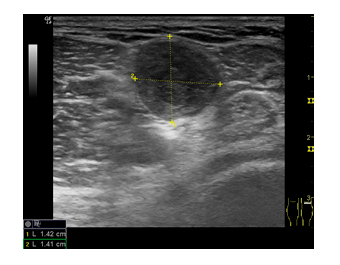
Figure 1: Short axis ultrasound imaging showing the tumour mass in the popliteal fossa.
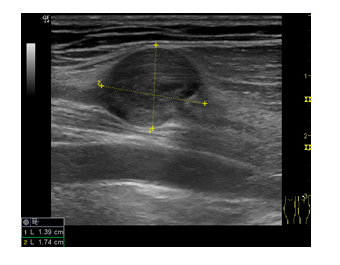
Figure 2: Long axis ultrasound imaging showing the tumour mass in the popliteal fossa.
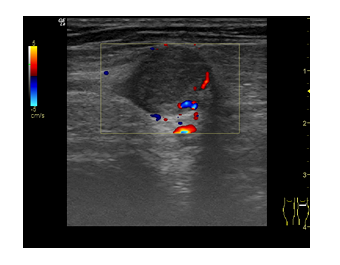
Figure 3: Power Doppler signal showing a vascularised lesion.
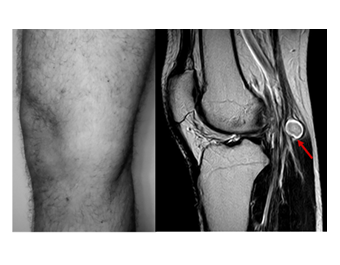
Figure 4: Sagittal plane Magnetic Resonance Imaging of the tibial nerve Schwannoma.
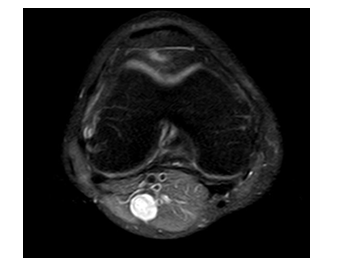
Figure 5: Transversal plane Magnetic Resonance Imaging of the tibial nerve Schwannoma.
3. Discussion
Although it is unusual, physical therapists are not exempt from the risk of facing red flags during their professional practice. Over the past two decades, the use of Rehabilitative Ultrasound Imaging (RUSI) has made it possible to refer multiple severe and malignant cases to appropriate healthcare professionals. There is wide evidence described in current literature about patient referrals to physical therapists with major pathologies that needed urgent care. This was the case of Mechelli et al. [6], whose patient with untypical low back pain was sent back to his physician with a high suspicion of malignancy. The existence of a 10-cm-diameter abdominal aortic aneurysm was radiologically confirmed and the patient finally underwent a surgical repair.
As Point of Care Ultrasound (POCUS) becomes to be a daily practice for clinicians, international meetings [7, 8] have accepted the use of ultrasound imaging in physical therapy, a fact that has resulted in early identification and medical/surgical treatment of many patients with underlying pathological diseases. Although unable to differentiate between schwannoma and other types of tumour such as neurofibrosarcomas, ultrasound imaging has proved to be a cost-effective and accessible tool for tumour localisation, but a positron emission tomography/computed tomography (PET/TC) and MRI must be used to make a final and accurate diagnosis [9-11]. In addition, as many of these benign tumours remain asymptomatic, delayed differential diagnoses together with symptomatic aggravation can be expected if they are not assessed very carefully [11], with only a 12% of patients diagnosed within the first year [12]. In 1992, Smith and Amis [13] published a patient case report showing an eight-year delay in the final diagnosis of neurilemmoma of distal tibial nerve, which was initially confused with a Morton neuroma of the first web space. Likewise, in the present case report the schwannoma was identified 15 years after the first clinical manifestations appeared. The neuropathic symptoms progression and a positive Tinnel sign in the popliteal fossa gave rise to a suspicion of a neurovascular disorder that required further examination and for this reason an ultrasound scan was performed.
Neuropathic pain in the popliteal fossa can be developed by a wide spectrum of compression etiologies. The most common causes of local neurovascular compression are the presence of Baker’s cysts, adventitial cysts of the popliteal artery, thrombophlebitic syndromes, synovial sarcomas, popliteal artery aneurysms and nerve entrapments [14, 15]. Nerve sheath tumours are very rare conditions, particularly in lower limb, since they represent 5% of all soft tissue tumours, but they can similarly result in neuropathic pain, which is typically misdiagnosed as lumbosacral radiculopathy [10].
Unlike neurofibromas, schwannomas tend to spread on the periphery of the nerve, and thereby do not invade neural tissue or provoke neuropathic symptoms unless compression of nerve fascicles occurs [10,13]. In some cases, the presence of schwannomas can be related to genetic syndromes known as neurofibromatosis type 2 (NF2) and schwannomatosis that lead to uncontrolled tumour development in nervous system [9, 16]. These conditions are associated with higher morbidity and early mortality from brainstem compression [16] with so varied clinical presentations that make it difficult to obtain an early diagnosis.
Moreover, although malignant transformation from benign tumours is considered to be rare [4, 11], the symptoms in this case made it necessary to excise the schwannoma, leading to the complete recovery of the patient. Literature considers excision as the treatment of choice in symptomatic scenarios [10] but there is no denying that iatrogenic events may appear during the surgical removal, becoming an important cause of postoperative neurological deficits as a consequence of damaging nerve fascicles, especially in cases of tumour enucleation [17].
The patient finally underwent surgery and neither postsurgical neuropathic pain nor functional impairment was referred after the surgical procedure. 12 months of follow-up confirmed the total recovery and the return to normal activity and patient’s previous sport practice.
Declarations
No benefits or funds were obtained to support this study. The authors have no conflict of interests to declare. Given the fact that no intervention took place, ethical approval was not required. The patient’s informed consent and all image permissions were obtained and signed for the anonymous information to be published. This manuscript (including abstract) is an original work and has not been previously published or submitted to any other publication.
Authors’ Contributions
LL participated in the study design, drafted and wrote the final manuscript. MTG performed all the data collection as well as submitted the case report. SF was responsible for obtaining the radiological images and DP collaborated with LL to draft the text and provided the facilities and equipment to carry out the radiology imaging. All the authors read and approved the final manuscript.
Acknowledgements
Not applicable.
References
- Albert P, Patel J, Badawy K, et al. Peripheral Nerve Schwannoma: A Review of Varying Clinical Presentations and Imaging Findings. J Foot Ankle Surg 56 (2017): 632-637.
- Rajasekaran RB, Shanmuganathan R. Schwannoma of the Posterior Tibial Nerve Presenting as Tarsal Tunnel Syndrome: A Case Report with Emphasis on the Role of Microscope during Surgery. Case Rep Orthop (2018): 1-4.
- Chalik N, Frydenberg E, Henry S, et al. Schwannoma of the tibial nerve–An unusual case of foot pain. Interdiscip Neurosurg 18 (2019): 100534.
- Kim DH, Murovic JA, Tiel RL, et al. A series of 397 peripheral neural sheath tumors: 30-year experience at Louisiana State University Health Sciences Center. J Neurosurg 102 (2005): 246-255.
- Blohm D, Hansen LB, Jakobsen BW. Hamstring pain in an athletic sprinter caused by a schwannoma of the sciatic nerve. Knee Surg Sports Traumatol Arthrosc 7 (1999): 135-136.
- Mechelli F, Preboski Z, Boissonnault W. Differential Diagnosis of a Patient Referred to Physical Therapy With Low Back Pain: Abdominal Aortic Aneurysm. J Orthop Sports Phys Ther 38 (2008): 551-557.
- Whittaker JL, Ellis R, Hodges PW, et al. Imaging with ultrasound in physical therapy: What is the PT’s scope of practice? A competency-based educational model and training recommendations. Br J Sports Med 53 (2019): 1447-1453.
- S F-C, C C-L, A G-M, et al. 2nd Rehabilitative Ultrasound Imaging Symposium in Physiotherapy – Madrid, Spain, 3–5 June 2016. Br J Sports Med 52 (2018): A1-A6.
- Daniel M, Waters D, Chen C, et al. Posterior tibial nerve schwannoma in a multiple myeloma patient: A case report. SAGE Open Med Case Rep 7 (2019): 2050313X1983844.
- Banshelkikar S, Nistane P. Intrasubstance Schwannoma of Posterior Tibial Nerve Presenting as Lumbo-Sacral Radiculopathy. Journal of Orthopaedic Case Reports 5 (2015): 35-37.
- Kim S-M, Seo S-W, Lee J-Y, et al. Surgical outcome of Schwannomas arising from major peripheral nerves in the lower limb. Int Orthop 36 (2012): 1721-1725.
- Nawabi DH, Sinisi M. Schwannoma of the posterior tibial nerve: The Problem of Delay In Diagnosis. J Bone Joint Surg Br 89-B 6 (2007):814-816.
- Smith W, Amis JA. Neurilemoma of the tibial nerve. A case report. J Bone Jt Surg 74 (1992): 443-444.
- English S, Perret D. Posterior knee pain. Curr Rev Musculoskelet Med 3 (2010): 3-10.
- Sanchez JE, Conkling N, Labropoulos N. Compression syndromes of the popliteal neurovascular bundle due to Baker cyst. J Vasc Surg 54 (2011): 1821-1829.
- Ardern-Holmes S, Fisher G, North K. Neurofibromatosis Type 2: Presentation, Major Complications, and Management, With a Focus on the Pediatric Age Group. J Child Neurol 32 (2017): 9-22.
- Takase K, Yamamoto K, Imakiire A. Clinical Pathology and Therapeutic Results of Neurilemmoma in the Upper Extremity. J Orthop Surg 12 (2004): 222-225.


 Impact Factor: * 5.3
Impact Factor: * 5.3 Acceptance Rate: 75.63%
Acceptance Rate: 75.63%  Time to first decision: 10.4 days
Time to first decision: 10.4 days  Time from article received to acceptance: 2-3 weeks
Time from article received to acceptance: 2-3 weeks 
